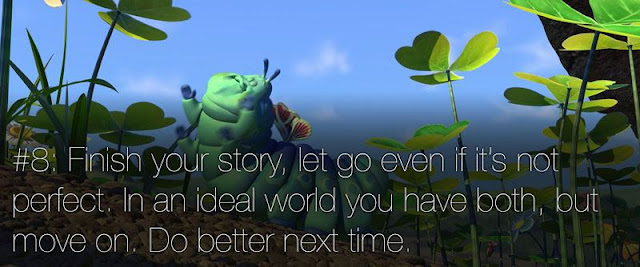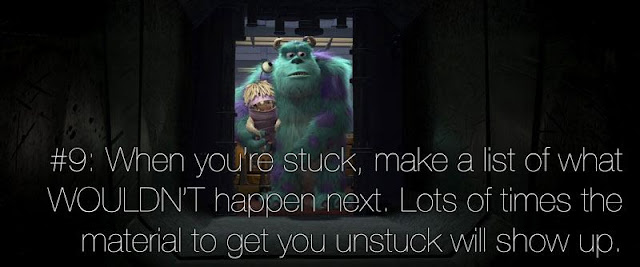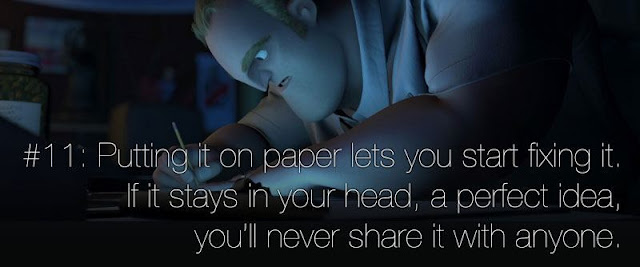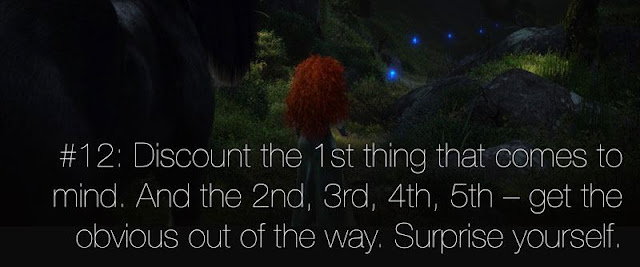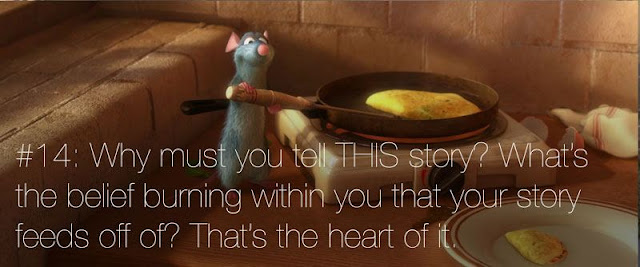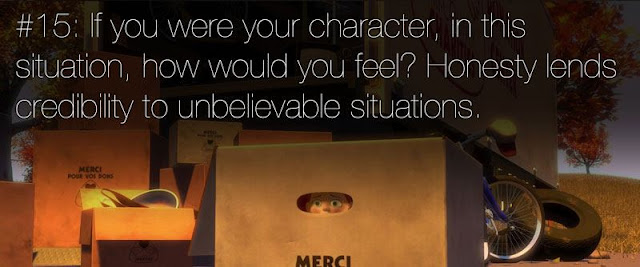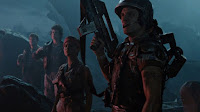Category: plot
March 30, 2017 / 1 Comment
Can’t Find The Target
By odd coincidence, this is post 404.
There’s an old development saying you’ve probably heard—let’s throw it at the wall and see what sticks. The premise here is that if we use every single idea we have, surely the good ones will do something to get noticed. They’ll stick to the wall or rise to the top or… something.
 The unwritten part of this premise is that you’ll also end up with a serious mess. Yeah, my two or three good ideas stuck to the wall, but look at all the crap piled up on the floor under them. Hell, look at the wall itself. It’s all stained and smeared and streaked. This isn’t a clean-up situation, it’s a straight repaint. I can say with confidence that we’re not getting our security deposit back.
The unwritten part of this premise is that you’ll also end up with a serious mess. Yeah, my two or three good ideas stuck to the wall, but look at all the crap piled up on the floor under them. Hell, look at the wall itself. It’s all stained and smeared and streaked. This isn’t a clean-up situation, it’s a straight repaint. I can say with confidence that we’re not getting our security deposit back. With all that in mind, I’d like to tell you the story of Phoebe McProtagonist…
Phoebe struggled through life from an early age, born ten months premature on the same day her father died in the Middle East, one week before his two-year tour ended. Overwhelmed with grief, her mother committed suicide during the birth. Phoebe’s years as an orphan in child protective services left her hard and jaded, and she never had a single role model—growing up without parents, foster parents, inspiring teachers, sports heroes, pop icons, internet stars, or even a giving tree.
In high school, Phoebe struggled with drug addiction, alcohol addiction, adrenaline addiction, video game addiction, sex addiction, a hoarding problem, OCD, Tourette’s syndrome, and extreme boredom because she wasn’t being challenged (no inspiring teachers, remember). She got pregnant three times on prom night, couldn’t get any abortions because she lived in a red state, then suffered four miscarriages from drinking lead-tainted Jaegerbombs after graduation.
(alcohol addiction, remember?)
 Determined to honor the memory of her unborn children, Phoebe withdrew from society and home-grad-schooled herself, eventually receiving magna cum laude, perfect attendance, and a triple doctorate in music theory, film criticism, and genetic engineering. Thus armed, she applied to be an astronaut and, after months of rigorous testing, was finally accepted into the astronaut training program by those goddamned f@¢%!#g bastards at NASA.
Determined to honor the memory of her unborn children, Phoebe withdrew from society and home-grad-schooled herself, eventually receiving magna cum laude, perfect attendance, and a triple doctorate in music theory, film criticism, and genetic engineering. Thus armed, she applied to be an astronaut and, after months of rigorous testing, was finally accepted into the astronaut training program by those goddamned f@¢%!#g bastards at NASA. (Tourette’s, remember?)
But when the rest of her team was killed in a launchpad fire that also burned down her house, Phoebe took time off to sort out her life. She sorted it out, got her groove back, got her ducks in a row, realized what’s important, and was struck by lightning walking along the beach. As she sprawled on the shore, feeling a moment of divine bliss and agony as all the hair on her body burned away, giant mutant fiddler crabs came out of the ocean, the product of unregulated industrial waste dumping—
(red state, remember? See how it all ties together? That’s what good literature does!)
—and dragged her away into the water. In her final moments, the race between drowning and being eaten alive by the mutant crabs, she realized the single secret to clean energy, FTL travel, and how to make the perfect 7&7. But there was no one to tell before she died, because she walked the beach alone.
~The End~
Okay, that was maybe a little bit over the top, but you might be surprised how common this kind of storytelling is. I saw it in writers’ groups in college (part of the reason I don’t belong to such groups anymore) and countless times when I used to read for screenplay contests. You wouldn’t believe the number of dramatic stories that are just brimming with excess plot devices and story threads. Hell, I freely admit some of the early drafts of The Suffering Map were the same way.
This springs from a common misconception–that writing a bunch of plot points and character elements is the same thing as writing a story. The logic is that if I load up my story with every possible dramatic idea for every single character, one of them’s bound to hit the target, right? And then, eventually, the story will be dramatic. Plus, adversity builds character, therefore it stands to reason all this extra adversity in my story will make for fantastic characters.
I mean, Phoebe comes across a great character, right…?
Simple truth is, this is all just excessive. If I’m doing this, I’m wasting ideas and wasting words, using thirty or forty examples instead of just three good ones. It’s the kind of thing that tells a reader I was more interested in creating art than I was in telling any kind of decent story.
Of course, in all fairness, it’s not just the artsy literature types who do this, although I must admit, they seem to be the most common offenders. We’ve all read (or seen) the action storywhere every punch draws blood, every car chase ends with an explosion, and every leap rattles bones. Plus every character had a snappy one-liner to toss out (or at least think about) before, during, and after offing one of the villains. And there were lots and lots of villains…
Then there’s the sci-fi stories that have vast interstellar conflicts and near-magical technology and unstoppable cyborg monsters and omnipotent, cosmic beingsand sacred orbs Seriously, reading contest scripts I was so sick of orbs. I came to loathe the word. Know what else? Nobody in bad fantasy ever has eyes, they all have orbs.
Friggin’ orbs.
 And sooooo many horror story that have cubic yards of blood and gore everywhere. Plus there’s a little chalk-skinned child who moves in high-speed “shaky vision.” And a secret psychopath. And one person who snaps and gets dozens of people killed because they opened a door or invited something in or played with the puzzle box.
And sooooo many horror story that have cubic yards of blood and gore everywhere. Plus there’s a little chalk-skinned child who moves in high-speed “shaky vision.” And a secret psychopath. And one person who snaps and gets dozens of people killed because they opened a door or invited something in or played with the puzzle box. It’s been almost thirty years, people. Thirty. Years. Haven’t you figured this out yet? Nothing good comes from opening the damned puzzle box! Even my mom knows this!
Y’see, Timmy, whatever my chosen genre is, just loading a bucket up with plot elements and flinging them at the wall does not create a story. It’s the opposite of writing in just about every way possible. No, not even if I only consider the leftover stuff. As I mentioned above, all those other ideas are still going to leave stains and streaks, no matter how solid the good stuff is.
Take that as you will.
Next week I’ll talk a bit more about cons, and I might talk about excessive stuff a little more, too.
Until then, go write.
February 16, 2017
My Latest Brilliant Idea
So, a few weeks ago I got to witness an all-too common event. The person whining about how “they stole my idea!” Who they were isn’t important. Sad truth is, it was a nonsense claim, one we’ve all seen more than a few times.
Here’s an ugly truth that all half-decent writers know. Ideas are cheap. They’re cheap, borderline worthless, because they’re common. Ridiculously common. I can say with absolute certainty that I have more ideas for books than I am ever going to be able to write. Seriously, even if I live to be a hundred, I’m pretty full up. And know what? I’m going to have more ideas tomorrow. And the day after that.
Not only that, but a lot of time my ideas will line up with the ideas other people have. This is called parallel creation, and it happens a lot. Especially when you consider how many folks come up with ideas they never do anything with.
Here’s an absolutely true story. Throughout 2008 and 2009, I placed in a few screenplay contests with a script I wrote called Reality Check. It was about the crew of a retro-style spaceship who slowly come to realize they’re actually characters in a 1950s serial. Eventually, they figure out how to escape into the real world—which turns out to be a far more terrifying and dangerous place than they’re prepared to deal with. Especially when one of their mortal enemies follows them through.
If this sounds vaguely familiar, it should. It’s got a lot of the same elements as John Scalzi’s Redshirts, a ridiculously fun book that came out about two years after I won my last contest with Reality Check (if memory serves, I got a free copy of Final Draft for that one).
Now, I’m sure some people would go nuts and start shrieking about plagiarism and lawsuits. Heck, I was dragged into a court case a few years back which was pretty clearly just weak parallel creation, but someone decided to sue over it anyway. And lost.
Simple truth is, Scalzi and I have never met (I think we were rushed past each other once at NYCC, but I’m not even sure of that). To the best of my knowledge he’s never been a judge or reader for a screenwriting contest. I have absolutely no reason to think he ever saw my story. We’re just two guys about the same age with similar educations, backgrounds, and interests who happened to look at something the same way and both decided to do something with it. I wrote a screenplay, he wrote a novel. That’s parallel creation.
There’s also a funny rule of thumb I heard a while back that I think is, alas, horribly true. The level of worry someone has about their idea being stolen is usually an inverse ratio to how good that idea actually is. In other words, people tend to get really paranoid about their bad clichés and tropes being stolen. That court case I mentioned before? It was based off some ridiculously common clichés. I mean, embarrassingly common. I actually laughed out loud when the lawyer told me they were part of the core basis of the lawsuit.
Y’see, Timmy, we all have ideas. And the simple truth is, there’s somebody out there with the same influences, the same education, the same resources as me who’s having the same idea. Maybe even ten or twenty people.
Now, let me bring up a related point to keep in mind about ideas. In fact, here’s another story. Genders, genres, and other facts have been changed (or maybe not) to protect the semi-innocent…
I was at a convention a while back and one of the other attending authors offered me a copy of her book. My to-read list is so huge I generally don’t accept such offers, but she was insistent so I said sure. And then it slowly worked its way through my to-read pile until it was at the top.
Said book was a fantasy novel that was aiming for a Game of Thrones-type feel. It was very big on swordfighting. Sword vs. sword, sword vs. axe, sword vs. two swords, sword vs. sword and a dagger…
 It just went on and on like this. Every fifth or sixth page had a sword fight. Or a flashback to a sword fight. Or someone talking about what they were going to do to someone else in an upcoming sword fight.
It just went on and on like this. Every fifth or sixth page had a sword fight. Or a flashback to a sword fight. Or someone talking about what they were going to do to someone else in an upcoming sword fight. And every battle ended bloody. No mercy in this world. Everyone either loses a head or an arm or gets impaled. Sometimes all three. Blood and guts sprayed everywhere and got on everyone. House of a 1000 Corpses looked clean and sanitized compared to this book.
Needless to say… it wasn’t that good. There were several places where the book bordered on awful. I read about fifty pages and skimmed the rest. More sword fights. More blood. A few beatings. The non-stop actionwasn’t the only issue, alas, but it was the one that matters for today.
Y’see, some of these battles were actually kind of clever. They did things I hadn’t seen before in books or on screen. The way they approached a character or their training. Some of the ways the fights went. How some of them were described.
But it’s not enough just to be original. My book needs to be coherent, both in plot and in structure. It needs to have flow. These are the things that tie my ideas together and turn them into a story.
I’ve mentioned before that ideas are rarely more than plot points, and a pile of plot points is not the same thing as a plot. No matter how clever my idea is, it’s not going to automatically make my story into a good story. Especially if… well, I don’t have a story. And an idea without a story is…
Well, it’s borderline worthless.
Next time, I’d like to put a few thoughts on the block.
Until then… go write.
Until then… go write.
February 7, 2017
Six Years Ago In Kazakhstan…
If any of you happen to follow me on Twitter, you know I have a habit of watching bad B-movies on the weekend–usually while I’m geeking a bit. While I do, I tweet out random observations about the story, dialogue, plot points, and so on. More often than not… they’re not positive ones.
There’s usually a lot of drinking going on, too.
A few weekends back I was watching this movie that went for the standard “group of assorted soldiers thrown into an unnatural situation” scenario. The same one that’s been kind of become the standard since Aliens did it with the Colonial Marines. Often copied, never duplicated, as they say.
 Maybe twenty minutes in, one of the civilians asked a grunt why they were all so dedicated to the sergeant. And said grunt told him this two or three minute story about how, five years ago, they’d been stationed on Theta Sigma, things went belly-up one night on patrol, and Sarge was the only one who kept it together. He got them out of that hell-zone on the death planet, and he even carried Bronsky for the last three miles.
Maybe twenty minutes in, one of the civilians asked a grunt why they were all so dedicated to the sergeant. And said grunt told him this two or three minute story about how, five years ago, they’d been stationed on Theta Sigma, things went belly-up one night on patrol, and Sarge was the only one who kept it together. He got them out of that hell-zone on the death planet, and he even carried Bronsky for the last three miles. Then, maybe thirty five-forty minutes in, one of the civilian scientists asked the lieutenant why he was such a hard ass. And he told her about how four years ago he’d been walking the perimeter, checking on his men, and he found some civilians in a restricted area. But he cut them some slack… and then the Lictors attacked. If he’d been hard then, if he’d sent them away as soon as he found them, those three people’d be alive today.
And then someone sat with the Sarge for a while as he recovered from a wound (he’d been impaled right through the chest, and that put him off his feet for, y’know, almost six hours). She asked how he could stay so positive, making jokes while the whole mission was turning to crap around them. And he told her about how, seven years ago, he’d been on this bug hunt on Ceti Alpha Five…
Look, you get the idea, right? Do I really need to finish that story?
Yeah, most movies don’t do it that many times, sure. Still… that element’s kind of become a standard in a lot of military stories, too, hasn’t it? The soldier/Marine/Amazon/Mooncop who gives us a flashback in dialogue to explain a strange bond, a weird character tic, or maybe even that scar she’s got that runs from her temple down past her jaw.
Y’see, Timmy, in Aliens the story only goes forward. We don’t need to go backwards to learn interesting stuff about these characters. We’re learning about them through how they react to things now, not how they reacted to them six years ago in Kazakhstan.
If the only way I can make my characters interesting is by flashing back six or seven years… maybe I don’t have interesting characters. Not now, anyway. It’s possible they were interesting back then, but if they’re interesting now… why’s all their character development in the past?
At the very least, I don’t have an interesting story. If I did, wouldn’t there be cool stuff happening now? Stuff my characters could be reacting to and giving the reader a better sense of who they are, even as it drives the plot and story forward?
If it’s only that recollection or flashback that’s making them cool… maybe that’s the story I should be telling.
Anyway, just wanted to toss that out real quick.
Thursday, our regularly scheduled post.
Until then, go write.


